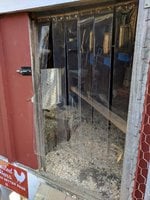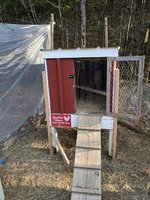Hello!
I am new to the chicken scene and am about to experience my first winter with chickens in New England. I have New Hampshire Reds so they are cold hardy birds but I wanted to make sure I appropriately ventilate and winterize my coop.
Attached are the images of my coop that I was given by a friend. Their are two doors, one really big in the front (there is a doggy door I put on it to prevent a lot of rain and snow getting in which has been an issue) and a smaller one on the side. The smaller one hits directly on their perches so I have a plastic sheet on that side of the run to prevent heavy wind gusts.
I have a temperature gauge in the coop and it pretty much is consistent to the outdoors: if it is 15F and humidity 62 outside, that's what it appears to be inside the coop. I want to make sure they are warm and healthy especially since we are about to get our first big snowfall and the temps are dropping to the single digits next week!
I want to avoid a lightbulb in the coop if possible. Does anyone have any ideas how I can properly ventilate and winterize this coop? Should I cover the side door or would that prevent air flow... Should I partially cover the doors to prevent some of the cold?
Any help would greatly be appreciated! Sorry for long post...


I am new to the chicken scene and am about to experience my first winter with chickens in New England. I have New Hampshire Reds so they are cold hardy birds but I wanted to make sure I appropriately ventilate and winterize my coop.
Attached are the images of my coop that I was given by a friend. Their are two doors, one really big in the front (there is a doggy door I put on it to prevent a lot of rain and snow getting in which has been an issue) and a smaller one on the side. The smaller one hits directly on their perches so I have a plastic sheet on that side of the run to prevent heavy wind gusts.
I have a temperature gauge in the coop and it pretty much is consistent to the outdoors: if it is 15F and humidity 62 outside, that's what it appears to be inside the coop. I want to make sure they are warm and healthy especially since we are about to get our first big snowfall and the temps are dropping to the single digits next week!
I want to avoid a lightbulb in the coop if possible. Does anyone have any ideas how I can properly ventilate and winterize this coop? Should I cover the side door or would that prevent air flow... Should I partially cover the doors to prevent some of the cold?
Any help would greatly be appreciated! Sorry for long post...






